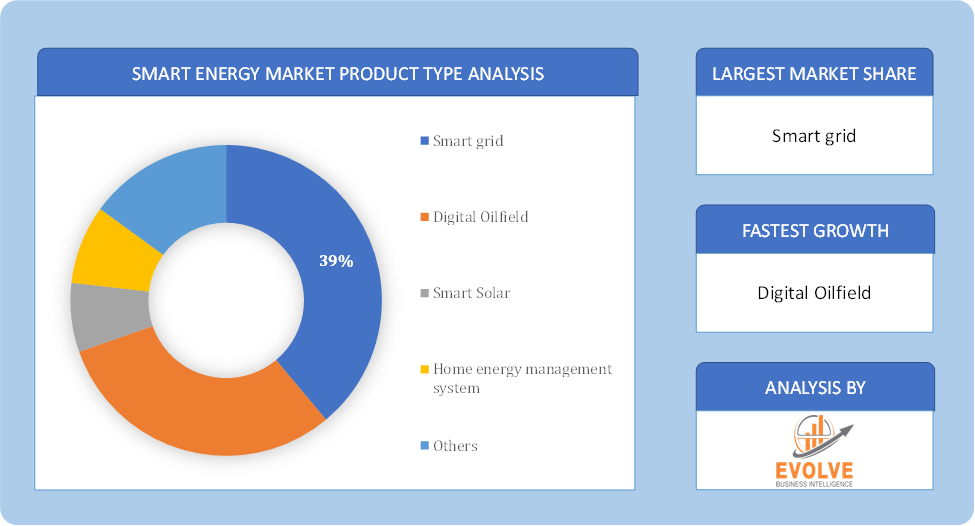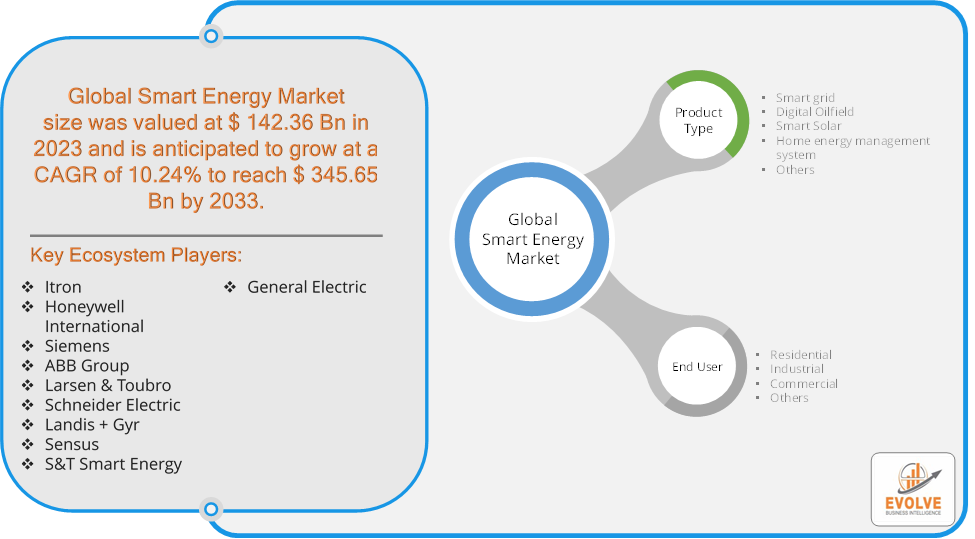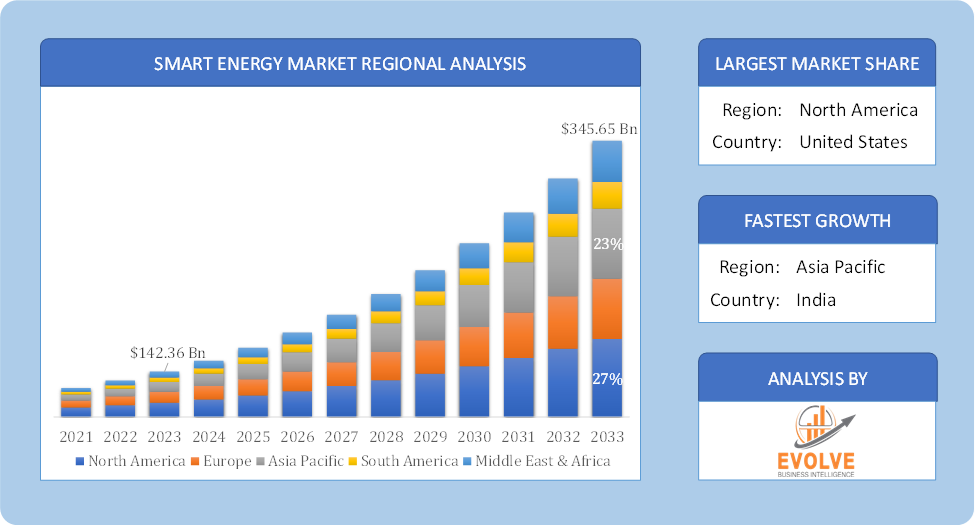Smart Energy Market Overview
The Smart Energy Market Size is expected to reach USD 345.65 Billion by 2033. The Smart Energy Market industry size accounted for USD 142.36 Billion in 2023 and is expected to expand at a compound annual growth rate (CAGR) of 10.24% from 2023 to 2033. The Smart Energy Market refers to the industry focused on the development and implementation of smart energy solutions that utilize advanced technologies to optimize the production, distribution, and consumption of energy. This market encompasses a wide range of products and services aimed at enhancing the efficiency, reliability, and sustainability of energy systems.
The smart energy market is driven by the increasing demand for sustainable energy solutions, government regulations promoting energy efficiency, and the rising adoption of Internet of Things (IoT) technologies in the energy sector. It aims to create a more resilient and efficient energy system that can support the transition to a low-carbon economy.
 Global Smart Energy Market Synopsis
Global Smart Energy Market Synopsis
COVID-19 Impact Analysis
The COVID-19 pandemic had a significant impact on the Smart Energy Market. Many smart energy projects faced delays due to disruptions in the supply chain, restrictions on movement, and financial uncertainty. This affected the deployment of smart meters, grid infrastructure upgrades, and renewable energy installations. With lockdowns and remote working becoming the norm, there was a noticeable shift in energy consumption patterns. Residential energy demand increased, while commercial and industrial demand declined. This shift challenged energy providers to adapt quickly, highlighting the importance of flexible and responsive energy systems. The pandemic accelerated the adoption of digital technologies as utilities and energy companies sought to improve remote monitoring and management of energy systems. The pandemic underscored the need for resilient and sustainable energy systems, driving interest in renewable energy sources and smart energy solutions. Utilities faced operational challenges due to workforce restrictions but also saw opportunities to enhance customer engagement through digital platforms and smart energy solutions.
Smart Energy Market Dynamics
The major factors that have impacted the growth of Smart Energy Market are as follows:
Drivers:
Ø Technological Advancements
The integration of IoT devices in energy systems allows for real-time monitoring and control, improving efficiency and reliability. Advanced data analytics enable better demand forecasting, grid management, and energy optimization. AI is used to enhance energy management systems, automate processes, and improve decision-making in energy distribution. Rising consumer awareness and demand for energy efficiency and control over energy usage are driving the adoption of smart meters and home energy management systems. The proliferation of smart homes and buildings is increasing demand for integrated energy solutions that offer convenience and cost savings. Rapid urbanization and the development of smart cities drive the need for modernized energy infrastructure that can support growing populations and energy demands.
Restraint:
- Perception of High Initial Costs and Cybersecurity Concerns
The upfront investment required for smart energy infrastructure, such as smart grids, meters, and renewable energy systems, can be substantial, deterring adoption, especially in developing regions. As energy systems become more digitized, they become more vulnerable to cyberattacks, raising concerns about data security and the reliability of smart energy systems.
Opportunity:
⮚ Renewable Energy Integration
Increasing the adoption of renewable energy sources like solar and wind offers significant opportunities for smart energy technologies to manage variability and enhance grid stability. Technologies such as microgrids and distributed energy resources can be leveraged to optimize the integration of renewables. The increasing use of IoT and AI in energy systems provides opportunities to develop innovative solutions for real-time monitoring, predictive maintenance, and automated energy management. Enhanced data analytics can offer insights into energy consumption patterns and improve decision-making.
Smart Energy Market Segment Overview
 By Product Type
By Product Type
Based on Product Type, the market is segmented based on Smart grid, Digital Oilfield, Smart Solar, Home energy management system and Others. The smart segment dominant the market. The smart grid is a digital technology that permits bidirectional communication between the utility and its consumers and aids with transmission line sensing. The intelligent grid consists of controllers, computers, automation, new technologies, and instrumentation operations. The smart grid improves problem detection and enables network self-healing by utilizing technologies like state estimation.
By End User
Based on End User, the market segment has been divided into Residential, Industrial, Commercial and Others. The industrial segment dominant the market. In the smart energy market, industrial end-users focus on implementing intelligent technologies to enhance operational efficiency, reduce energy consumption, and ensure sustainability. Industrial trends include the integration of smart sensors for real-time monitoring, predictive maintenance through IoT, and the adoption of energy analytics for optimized resource utilization. These innovations empower industries to streamline production processes, minimize downtime, and contribute to eco-friendly practices, aligning with the growing emphasis on sustainable industrial operations.
Global Smart Energy Market Regional Analysis
Based on region, the global Smart Energy Market has been divided into North America, Europe, Asia-Pacific, the Middle East & Africa, and Latin America. North America is projected to dominate the use of the Smart Energy Market followed by the Asia-Pacific and Europe regions.
 Smart Energy North America Market
Smart Energy North America Market
North America holds a dominant position in the Smart Energy Market. North America region has a well-established smart energy market, driven by policies promoting clean energy and a robust technological ecosystem. The focus here is on smart meter deployment and grid modernization. Growing demand for electric vehicles and supporting infrastructure.
Smart Energy Asia-Pacific Market
The Asia-Pacific region has indeed emerged as the fastest-growing market for the Smart Energy Market industry. Asia Pacific region is expected to see the fastest growth in the Smart Energy Market. Rapid urbanization and a growing need for reliable energy are driving the market forward. Significant investments from governments in countries like China and India are fueling large-scale smart grid implementations and renewable energy ventures. Rising energy demand from expanding urban populations and industrial sectors.
Competitive Landscape
The global Smart Energy Market is highly competitive, with numerous players offering a wide range of software solutions. The competitive landscape is characterized by the presence of established companies, as well as emerging startups and niche players. To increase their market position and attract a wide consumer base, the businesses are employing various strategies, such as product launches, and strategic alliances.
Prominent Players:
- Itron
- Honeywell International
- Siemens
- ABB Group
- Larsen & Toubro
- Schneider Electric
- Landis + Gyr
- Sensus
- S&T Smart Energy
- General Electric
Key Development
In May 2022, GE Digital has unveiled a Distributed Energy Resource Management System (DERMS) solution, contributing to a safer, secure, and resilient electric grid. The software integrates intelligence, operations, economics, and markets in a unified platform, empowering grid operators to efficiently manage and optimize Distributed Energy Resources (DERs) for clean, reliable, and affordable energy delivery.
In May 2022, Itron is expanding its collaboration with Microsoft to accelerate the energy transition. The partnership merges Itron’s energy management solutions with Microsoft’s cloud offerings, revolutionizing how users perceive and manage energy. Together, they aim to provide utilities with innovative solutions, promoting grid resilience, consumer engagement, operational efficiency, and decarbonization.
Scope of the Report
Global Smart Energy Market, by Product Type
Smart grid
- Digital Oilfield
- Smart Solar
- Home energy management system
- Others
Global Smart Energy Market, by End User
- Residential
- Industrial
- Commercial
- Others
Global Smart Energy Market, by Region
- North America
- US
- Canada
- Mexico
- Europe
- UK
- Germany
- France
- Italy
- Spain
- Benelux
- Nordic
- Rest of Europe
- Asia Pacific
- China
- Japan
- South Korea
- Indonesia
- Austalia
- Malaysia
- India
- Rest of Asia Pacific
- South America
- Brazil
- Argentina
- Rest of South America
- Middle East & Africa
- Saudi Arabia
- UAE
- Egypt
- South Africa
- Rest of Middle East & Africa
| Parameters | Indicators |
|---|---|
| Market Size | 2033: USD 345.65 Billion |
| CAGR (2023-2033) | 10.24% |
| Base year | 2022 |
| Forecast Period | 2023-2033 |
| Historical Data | 2021 (2017 to 2020 On Demand) |
| Report Coverage | Revenue Forecast, Competitive Landscape, Growth Factors, and Trends |
| Key Segmentations | Product Type, End User |
| Geographies Covered | North America, Europe, Asia-Pacific, South America, Middle East, Africa |
| Key Vendors | Itron, Honeywell International, Siemens, ABB Group, Larsen & Toubro, Schneider Electric, Landis + Gyr, Sensus, S&T Smart Energy and General Electric. |
| Key Market Opportunities | · Renewable Energy Integration |
| Key Market Drivers | · Technological Advancements · Consumer Demand for Efficiency and Control |
REPORT CONTENT BRIEF:
- High-level analysis of the current and future Smart Energy Market trends and opportunities
- Detailed analysis of current market drivers, restraining factors, and opportunities in the future
- Smart Energy Market historical market size for the year 2021, and forecast from 2023 to 2033
- Smart Energy Market share analysis at each product level
- Competitor analysis with detailed insight into its product segment, Government & Defense strength, and strategies adopted.
- Identifies key strategies adopted including product launches and developments, mergers and acquisitions, joint ventures, collaborations, and partnerships as well as funding taken and investment done, among others.
- To identify and understand the various factors involved in the global Smart Energy Market affected by the pandemic
- To provide a detailed insight into the major companies operating in the market. The profiling will include the Government & Defense health of the company’s past 2-3 years with segmental and regional revenue breakup, product offering, recent developments, SWOT analysis, and key strategies.


 Global Smart Energy Market Synopsis
Global Smart Energy Market Synopsis Smart Energy North America Market
Smart Energy North America Market

